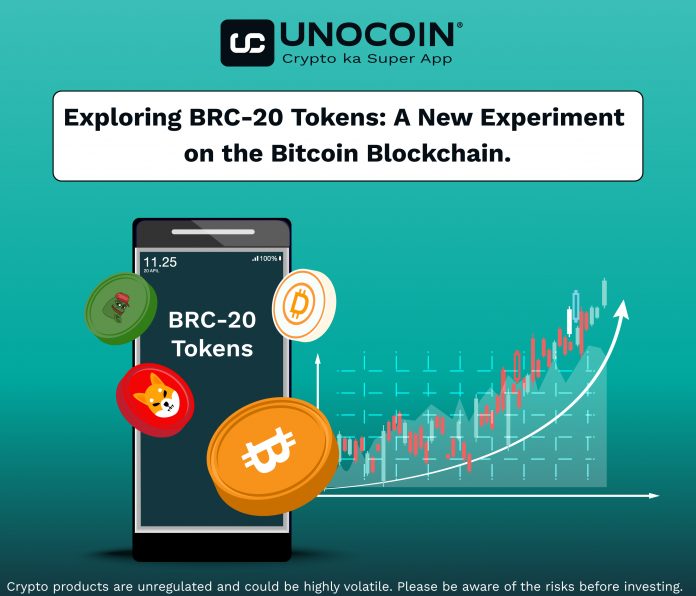Introducing BRC-20 Tokens
BRC-20 tokens are an experimental token standard built on the Bitcoin blockchain that enables the creation and transfer of fungible tokens. Similar to ERC-20 Ethereum tokens, BRC-20 tokens have their own unique mechanisms and features.
Creation and background
In January 2023, the Bitcoin Ordinals protocol enabled non-fungible tokens (NFTs) to be written on satoshis (sats). This led to the development of the BRC-20 token standards in March 2023 by a programmer named Domo, which allows the minting of fungible tokens on the Bitcoin blockchain. The first BRC-20 token introduced was “ordi”, followed by many other tokens, including meme tokens, in the following months. Increased demand for BRC-20 tokens has led to congestion on the Bitcoin network and higher transaction fees.
The functionality of BRC-20 tokens
Understanding the Bitcoin Ordinals protocol is essential to understanding BRC-20 tokens. The protocol assigns satoshi numbers, allowing additional data to be attached through a process called “writing”. BRC-20 tokens use JavaScript Object Notation (JSON) within Ordinals to deploy token contracts, mint tokens, and facilitate conversions. While the process of deploying, minting, and transferring BRC-20 tokens is not yet user-friendly, it involves token deployment, quantity minting, and token transfer through specific functions.
Differences from ERC-20 tokens
Although the names may sound similar, BRC-20 tokens and ERC-20 tokens have significant differences. BRC-20 tokens operate on the Bitcoin network and lack the advanced features of ERC-20 tokens because they do not use smart contracts. In contrast, ERC-20 tokens on the Ethereum network can interact with various protocols and applications, enabling services such as lending and borrowing. ERC-20 tokens have been around since 2015, gaining recognition in 2017 and undergoing extensive testing and use, while BRC-20 tokens are still in their early stages and face uncertain prospects.
Risks and Considerations
BRC-20 tokens are an ongoing experiment to improve fungibility on the Bitcoin blockchain, which carries its own risks. Despite the initial hype, these tokens currently offer limited utility and their future remains uncertain. Considering the ease of minting BRC-20 tokens, many may end up with little or no value. Therefore, users and investors should exercise caution, thoroughly research tokens and be aware of the associated risks before engaging in this new token standard.
The BRC20 token economy is booming and dominating the ordi
The BRC20 token standard, built on the Bitcoin network, is experiencing significant growth. As of May 7, 2023, the total value of the BRC20 token economy has reached $279.07 million, with more than 13,530 tokens in circulation. This represents a substantial increase from just four days prior when the market cap was $95 million and approximately 10,487 BRC20 tokens were available.
Leader token: ordi
The most valuable BRC20 token is currently ordi, an exchange at $9.46 per token. With a market cap of $200 million, ordi dominates the BRC20 token market, accounting for more than 71% of its total capitalization. Not only does Ordi hold the top spot in terms of market capitalization, but it also generated a 24-hour trading volume of $3.1 million.
Unleashing the Potential: Bitcoin Ordinals and the Rise of Bitcoin NFTs
In a landscape dominated by Ethereum, Solana and BNB Smart Chain, a pioneering protocol is emerging to revolutionize the Bitcoin blockchain. Enter Ordinals, a pioneering project that believes non-fungible tokens (NFTs) have a rightful place in the Bitcoin realm. With their unique approach, Ordinals unlocked a new wave of possibilities and ushered in the era of Bitcoin NFTs.
Discovering New Horizons:
The path to Bitcoin NFTs has been challenging due to the decentralized nature of the Bitcoin network. However, the expanding crypto ecosystem has welcomed innovative thinkers who envision Bitcoin as an integral part of Web3, fueling the birth of the Ordinals project.
Cracking the code:
Ordinals introduce a new concept called an “inscription” that gives each individual satoshi a distinct identity. By attaching additional data to satoshis, Ordinals effectively transform them into unique entities. Unlike traditional NFTs that rely on external smart contracts and asset hosting, Ordinals write directly to satoshis, leveraging the immutable and secure nature of the Bitcoin blockchain itself.
Power of Ordinal Theory:
Through the groundbreaking Ordinal Theory, every satoshi can now be identified and tracked, from its initial minting through its entire transaction lifecycle. These inscriptions serve as digital assets, similar to NFTs, etched into satoshis on the Bitcoin network. This monumental achievement was made possible by improvements to Taproot that eliminate the need for sidechains or separate tokens.
Rarity Revealed:
Interestingly, Ordinal Theory grants satoshis rarity based on their properties. Common, uncommon, rare, epic, legendary, and mythic satoshis each have a specific rank that defines their scarcity within the Bitcoin supply. These differences add to the allure of satoshi collecting and offer enthusiasts an exciting pursuit of digital rarity.
The debate for and against:
Like any disruptive innovation, Ordinals have sparked a wild debate in the Bitcoin community. Proponents say the protocol expands the utility of the Bitcoin network beyond transfers of value and introduces new features and opportunities. However, critics raise concerns about increased network fees resulting from enrolled satoshis competing for block space. Despite the controversy, Ordinals is undeniably bringing a new wave of innovation to the Bitcoin space.
Look into the future:
Ordinals represent a pivotal moment in Bitcoin’s history, expanding its potential beyond traditional use cases. By allowing information to be stored within Bitcoin transactions, it allows creators and enthusiasts alike to explore new avenues in blockchain art. The future trajectory of Ordinals remains uncertain, but one thing is clear – Bitcoin is evolving, and the waves of that evolution are changing the very fabric of the crypto landscape.
Other notable tokens
Top BRC20 tokens include pepe, piza, meme, moon, punk, domo, oshi, xing and shib. With a market cap of around $17.6 million, Pepe stands out as another notable token within the BRC20 ecosystem.
Overall market composition
The top five BRC20 tokens, including ordi, pepe, piza, meme and moon, together account for 86.55% of the total market cap of $279.07 million. The BRC20 token economy demonstrates strong growth and diversification within the Bitcoin network, indicating its growing importance and acceptance.
Please find the list of authentic Unocoin accounts for all your queries below:
- YouTube Channel: https://www.youtube.com/c/Unocoin/videos
- Newsletter: https://medium.com/subscribe/@Unocoin_growth
- Blogs: https://blog.unocoin.com
- Instagram: https://www.instagram.com/unocoin/
- Twitter: https://twitter.com/Unocoin
- Facebook: https://www.facebook.com/unocoin/
- LinkedIn: https://in.linkedin.com/company/unocoin
- Telegram Group: https://t.me/Unocoin_Group
- Telegram Channel: https://t.me/+fasQhTKBsfA5N2Zl
- Telegram: https://t.me/UnocoinSupport_Bot
- E-mail id: [email protected]
- Contact details: 7788978910 (09:30 AM IST – 06:30 PM, Mon – Sat)
- App store link: https://apps.apple.com/us/app/unocoin/id1030422972?ls=1
- Playstore link: https://play.google.com/store/apps/details?id=com.unocoin.unocoinwallet
Disclaimer: Crypto products are unregulated as of this date in India. They could be highly volatile. At Unocoin, we understand that there is a need to protect consumer interests as this form of trading and investment has risks that consumers may not be aware of. To ensure that consumers who deal in crypto products are not misled, they are advised to DYOR (Do Your Own Research).




